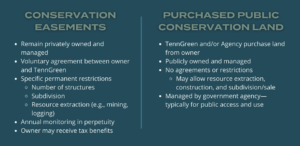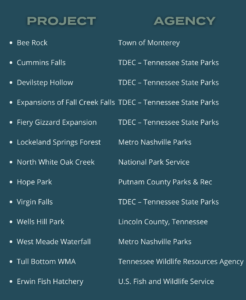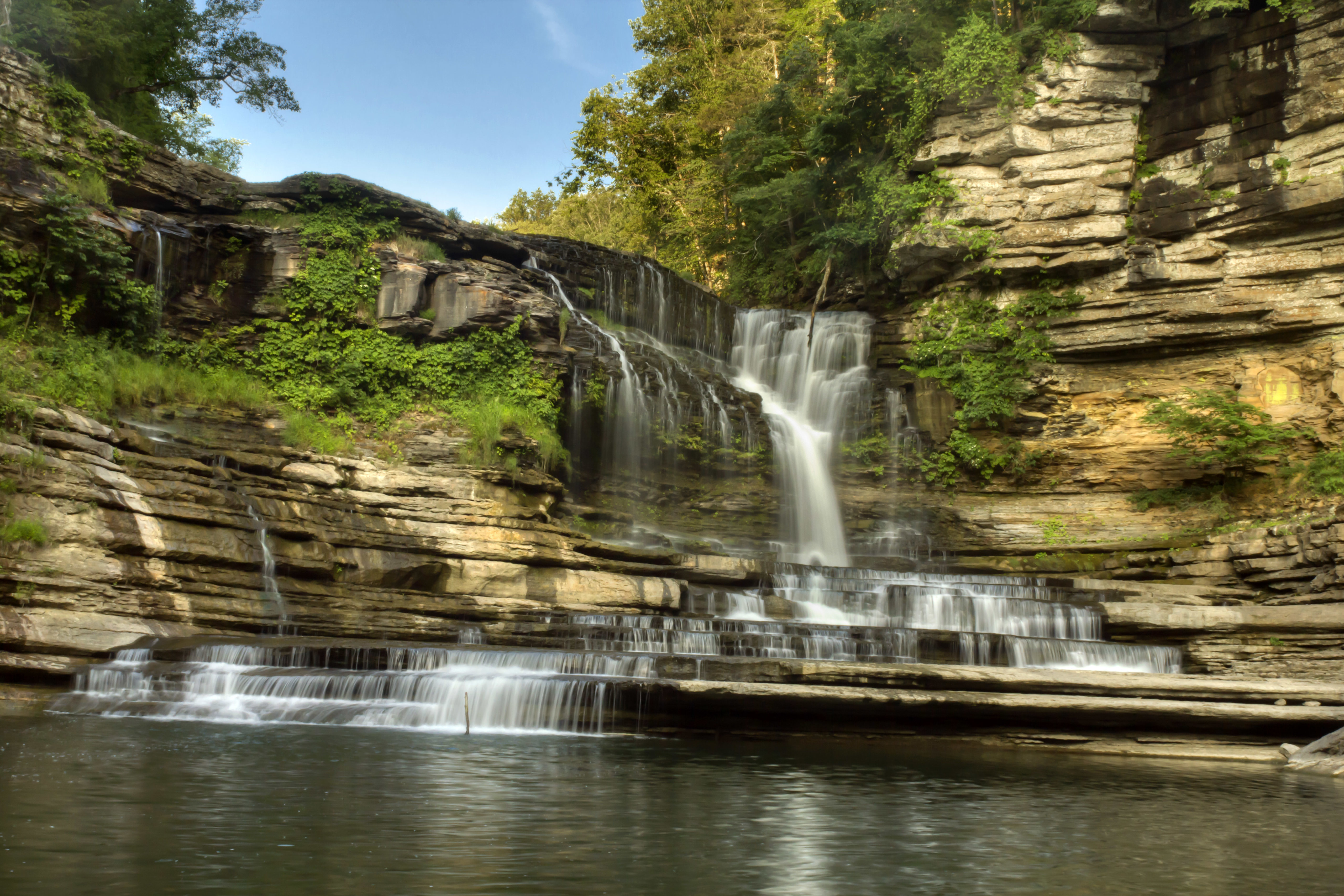TennGreen Land Conservancy protects land through purchases, conservation easements, and donation. Typically, purchased land later becomes public conservation land—like a State Park, State Natural Area, or Wildlife Management Area—whereas a conservation easement protects land that remains private property. So, what are the other differences between the two? Why does purchase make sense in some cases, while conservation easements are more appropriate in others?
CONSERVATION EASEMENT VS. LAND PURCHASE

Ownership
The most significant benefit of conservation easements is that they allow land to be protected while remaining in private hands. The landowner and TennGreen agree to specific terms—enforced forever by TennGreen with annual monitoring. These terms are extremely tailorable to the landowner’s unique conservation goals, but can include items like:
- Restrictions on the number of residences that can be built
- Restrictions on the harvesting of timber or agricultural practices
- Reservation of rights such as hunting, fishing, and trail building
- A maximum number of times the parcel can be split among owners
On the other hand, a public agency typically owns public conservation land. Agencies sometimes identify parcels they hope to purchase one day but may request a nonprofit partner to assist with proactive acquisitions. More often, a landowner ready to sell will approach TennGreen or an agency hoping to get an offer.
TennGreen played a role in establishing the following public conservation lands, among many others:

Pros and Cons of Public Conservation Lands
The conservation of land for public benefit has been a focus in the U.S. since the late 1800s. Since then, several agencies have been created at the Federal level and in every state to manage parks, forests, wildlife refuges, seashores, recreation areas, historic sites, and other designations. Many of these lands are used for recreation, such as hiking, camping, climbing, hunting, off-road vehicle use, mountain biking, skiing, and more. The agencies that manage public lands support different objectives, and some public lands allow and promote sustainable timber harvest, petroleum exploration, tourism, and other economic activity.
Public land pros:
- Dedicated agency staff are mandated to manage land
- Most agencies highly value access for all people
- Agencies can update management practices as forest and rangeland science changes over time
- Agencies can adapt to problems that arise which threaten the conservation values of the land
- Land can be used to generate revenue that benefits the public
- Land can stimulate the local economy, often in remote and rural areas
- Land is unlikely to be transferred, so long-term (hundred years or more) planning is possible
Public land cons:
- Agencies are beholden to the current administration’s policies
- Agencies are frequently understaffed and underfunded, leading to a backlog of management tasks
- Public recreation can be damaging to the conservation values of land
- Extractive practices can be unpopular and can damage conservation values
- Permitting and entry fees restrict access to privileged groups
- Agencies do not always want to acquire a piece of land due to the burden of ownership
Pros and Cons of Conservation Easements
Conservation easements are a somewhat less commonly used conservation strategy. Nonprofit land conservancies, like TennGreen, typically hold easements. These organizations hold a portion of the landowner’s rights “in trust,” such as the right to develop or subdivide the land. By holding these rights, the land conservancy restricts the owner from exercising them, thus protecting the land’s conservation values from those specific practices.
Conservation easement pros:
- Annual monitoring continues in perpetuity, guaranteeing the easement terms are upheld
- Land remains in private hands and can continue to be used and enjoyed by individual owners, families, or businesses
- Land can be sold or passed down to heirs while the conservation easement remains in place
- May reduce the taxable value of the land
- Terms are voluntary, so the owner (at the time the easement is written) gives up only the rights that they choose
- Terms are legally binding on all future owners
- Easement is recorded in the land records, forever binding it to the deed and title
- Violations of easement terms can be brought before a judge for legal remedy
- Owner may be eligible for tax benefits
Conservation easement cons:
- Typically does not allow public access, unless stipulated in the easement
- Does not protect against eminent domain
- Perpetual cost of monitoring falls on the land conservancy, which must have a sustainable business model to ensure the protection of the property
- Cannot be used to enforce management practices that a landowner does not want to perform (except when the landowner has violated the easement terms)
- e.g., if an invasive plant is carried onto the property by wildlife, the owner usually cannot be forced to remove it
- e.g., if a future owner wants to stop maintaining a meadow area or agricultural zone, they cannot be compelled to do so unless the terms of the easement require it
HOW TO CHOOSE
If you own land that you believe has a high value for conservation, you may want to see it permanently protected. If you want to continue to own your land, a conservation easement is the best tool to protect it from future threats. But if you plan to sell, TennGreen or a public agency may not be willing or able to purchase your land.
Conservation easements protect land from specific practices: subdivision, building and development, and natural resource extraction. A conservation easement does not automatically result in public access or use. However, this is where the voluntary terms of a conservation easement can be of great value.
Combining Conservation Easements and Public Land
Occasionally, a landowner may think their property would be an ideal state-owned park or refuge. However, a public partner may not be ready to acquire the land for a park. Luckily, a conservation easement on a property does not limit that property’s ability to become a park or refuge, as long as the easement terms do not restrict public use and management activities. TennGreen has established conservation easements on properties decades before these lands became public properties. As long as the public agency is comfortable with the easement terms, it can still become a park or refuge.
Land Donations
Donating land significantly reduces the barriers to agency ownership but still does not guarantee that an agency will accept the land. Donating land to TennGreen is the simplest way to protect your land for future generations. If you’re interested in donating land to TennGreen or protecting it with a conservation easement, learn more about your options HERE.

